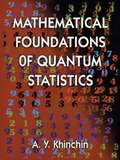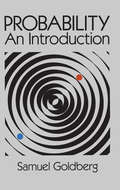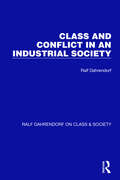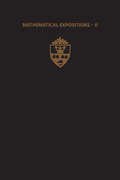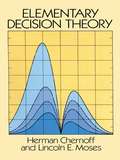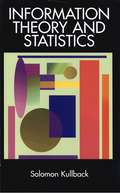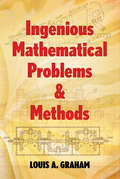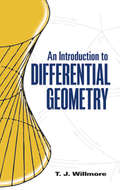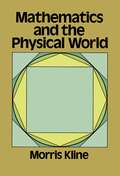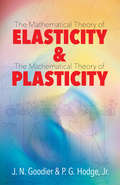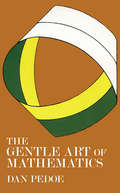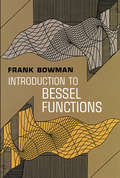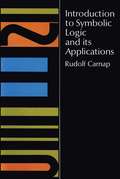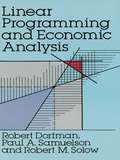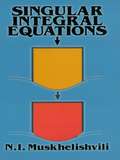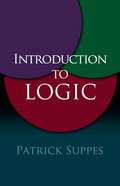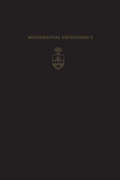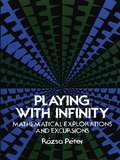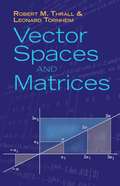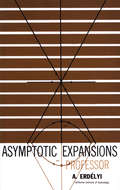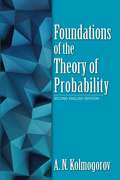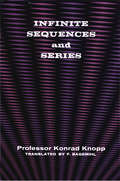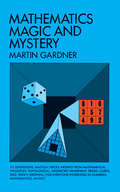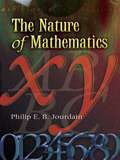- Table View
- List View
Mathematical Foundations of Quantum Statistics (Dover Books on Mathematics)
by A. Y. KhinchinA coherent, well-organized look at the basis of quantum statistics’ computational methods, the determination of the mean values of occupation numbers, the foundations of the statistics of photons and material particles, thermodynamics.
Probability: An Introduction
by Samuel GoldbergExcellent basic text covers set theory, probability theory for finite sample spaces, binomial theorem, probability distributions, means, standard deviations, probability function of binomial distribution, and other key concepts and methods essential to a thorough understanding of probability. Designed for use by math or statistics departments offering a first course in probability. 360 illustrative problems with answers for half. Only high school algebra needed. Chapter bibliographies.
Class and Conflict in an Industrial Society (Ralf Dahrendorf on Class & Society #1)
by Ralf DahrendorfOriginally published in England in 1959, this book evolves a new theory of conflict in industrial society. By way of illustrating and testing this theory, the book provides detailed analyses of various social phenomena. The author carries out a full critique of Marx in the light of history and modern sociology and discusses the theories of class-conflict of James Burnham, Fritz Croner and Karl Renner.
Differential Geometry (Mathematical Expositions #no. 11)
by Erwin KreyszigThis book is intended to meet the need for a text introducing advanced students in mathematics, physics, and engineering to the field of differential geometry. It is self-contained, requiring only a knowledge of the calculus. The material is presented in a simple and understandable but rigorous manner, accompanied by many examples which illustrate the ideas, methods, and results. The use of tensors is explained in detail, not omitting little formal tricks which are useful in their applications. Though never formalistic, it provides an introduction to Riemannian geometry.<P><P> The theory of curves and surfaces in three-dimensional Euclidean space is presented in a modern way, and applied to various classes of curves and surfaces which are of practical interest in mathematics and its applications to physical, cartographical, and engineering problems. Considerable space is given to explaining and illustrating basic concepts such as curve, arc length, surface, fundamental forms; covariant and contravariant vectors; covariant, contravariant and mixed tensors, etc.<P> Interesting problems are included and complete solutions are given at the end of the book, together with a list of the more important formulae. No pains have been spared in constructing suitable figures.
Elementary Decision Theory (Dover Books on Mathematics)
by Lincoln E. Moses Herman Chernoff"The text is very clearly written [with] many illustrative examples and exercises [and] should be considered by those instructors who would like to introduce a more modern (and a more logical) approach in a basic course in statistics." --Journal of the American Statistical AssociationThis volume is a well-known, well-respected introduction to a lively area of statistics. Professors Chernoff and Moses bring years of professional expertise as classroom teachers to this straightforward approach to statistical problems. And happily, for beginning students, they have by-passed involved computational reasonings which would only confuse the mathematical novice.Developed from nine years of teaching statistics at Stanford, the book furnishes a simple and clear-cut method of exhibiting the fundamental aspects of a statistical problem. Beginners will find this book a motivating introduction to important mathematical notions such as set, function and convexity. Examples and exercises throughout introduce new topics and ideas.The first seven chapters are recommended for beginning courses in the basic ideas of statistics and require only a knowledge of high school math. These sections include material on data processing, probability and random variables, utility and descriptive statistics, uncertainty due to ignorance of the state of nature, computing Bayes strategies and an introduction to classical statistics. The last three chapters review mathematical models and summarize terminology and methods of testing hypotheses. Tables and appendixes provide information on notation, shortcut computational formulas, axioms of probability, properties of expectations, likelihood ratio test, game theory, and utility functions.Authoritative, yet elementary in its approach to statistics and statistical theory, this work is also concise, well-indexed and abundantly equipped with exercise material. Ideal for a beginning course, this modestly priced edition will be especially valuable to those interested in the principles of statistics and scientific method.
Information Theory and Statistics
by Solomon KullbackHighly useful text studies logarithmic measures of information and their application to testing statistical hypotheses. Includes numerous worked examples and problems. References. Glossary. Appendix. 1968 2nd, revised edition.
Ingenious Mathematical Problems and Methods
by Louis A. GrahamFor two decades, an international readership of workers in applied mathematics submitted their favorite puzzles to a mid-twentieth-century column, The Graham Dial. This original collection features 100 of the publication's very best problems, with themes ranging from logic and engineering situations to number theory and geometry. Each problem was specifically selected for its widely differing modes of solution, and most include several methods of solution plus assessments of their efficacy.In checking their solutions against the book's, readers may find that their interest in the puzzles increases. The search for an answer can develop into a challenge to improve upon existing solutions, as in a friendly competition among dozens of keen-witted, problem-solving engineers and mathematical puzzle fans. More than two dozen "mathematical nursery rhymes" appear throughout the book, which concludes with a final section of 25 "quickies" that will test readers' speed.
An Introduction to Differential Geometry
by T. J. WillmoreA solid introduction to the methods of differential geometry and tensor calculus, this volume is suitable for advanced undergraduate and graduate students of mathematics, physics, and engineering. Rather than a comprehensive account, it offers an introduction to the essential ideas and methods of differential geometry.Part 1 begins by employing vector methods to explore the classical theory of curves and surfaces. An introduction to the differential geometry of surfaces in the large provides students with ideas and techniques involved in global research. Part 2 introduces the concept of a tensor, first in algebra, then in calculus. It covers the basic theory of the absolute calculus and the fundamentals of Riemannian geometry. Worked examples and exercises appear throughout the text.
Mathematics and the Physical World
by Morris Kline"Kline is a first-class teacher and an able writer. . . . This is an enlarging and a brilliant book." - Scientific American"Dr. Morris Kline has succeeded brilliantly in explaining the nature of much that is basic in math, and how it is used in science." - San Francisco ChronicleSince the major branches of mathematics grew and expanded in conjunction with science, the most effective way to appreciate and understand mathematics is in terms of the study of nature. Unfortunately, the relationship of mathematics to the study of nature is neglected in dry, technique-oriented textbooks, and it has remained for Professor Morris Kline to describe the simultaneous growth of mathematics and the physical sciences in this remarkable book. In a manner that reflects both erudition and enthusiasm, the author provides a stimulating account of the development of basic mathematics from arithmetic, algebra, geometry, and trigonometry, to calculus, differential equations, and the non-Euclidean geometries. At the same time, Dr. Kline shows how mathematics is used in optics, astronomy, motion under the law of gravitation, acoustics, electromagnetism, and other phenomena. Historical and biographical materials are also included, while mathematical notation has been kept to a minimum. This is an excellent presentation of mathematical ideas from the time of the Greeks to the modern era. It will be of great interest to the mathematically inclined high school and college student, as well as to any reader who wants to understand - perhaps for the first time - the true greatness of mathematical achievements.
Elasticity and Plasticity: The Mathematical Theory of Elasticity and The Mathematical Theory of Plasticity (Dover Books on Mathematics)
by J. N. Goodier P. G. Hodge Jr.This volume comprises two classic essays on the mathematical theories of elasticity and plasticity by authorities in this area of engineering science. Undergraduate and graduate students in engineering as well as professional engineers will find these works excellent texts and references. The Mathematical Theory of Elasticity covers plane stress and plane strain in the isotropic medium, holes and fillets of assignable shapes, approximate conformal mapping, reinforcement of holes, mixed boundary value problems, the third fundamental problem in two dimensions, eigensolutions for plane and axisymmetric states, anisotropic elasticity, thermal stress, elastic waves induced by thermal shock, three-dimensional contact problems, wave propagation, traveling loads and sources of disturbance, diffraction, and pulse propagation. The Mathematical Theory of Plasticity explores the theory of perfectly plastic solids, the theory of strain-hardening plastic solids, piecewise linear plasticity, minimum principles of plasticity, bending of a circular plate, and other problems.
The Gentle Art of Mathematics
by Dan PedoeMathematical games, probability, the question of infinity, topology, how the laws of algebra work, problems of irrational numbers, and more. 42 figures.
Introduction to Bessel Functions (Dover Books on Mathematics)
by Frank BowmanA full, clear introduction to the properties and applications of Bessel functions, this self-contained text is equally useful for the classroom or for independent study. Topics include Bessel functions of zero order, modified Bessel functions, definite integrals, asymptotic expansions, and Bessel functions of any real order. More than 200 problems throughout.
Introduction to Symbolic Logic and Its Applications
by Rudolf CarnapA clear, comprehensive, and rigorous treatment develops the subject from elementary concepts to the construction and analysis of relatively complex logical languages. It then considers the application of symbolic logic to the clarification and axiomatization of theories in mathematics, physics, and biology. Hundreds of problems, examples, and exercises. 1958 edition.
Linear Programming and Economic Analysis (Dover Books on Computer Science)
by Paul A. Samuelson Robert M. Solow Robert DorfmanDesigned primarily for economists and those interested in management economics who are not necessarily accomplished mathematicians, this text offers a clear, concise exposition of the relationship of linear programming to standard economic analysis. The research and writing were supported by The RAND Corporation in the late 1950s.Linear programming has been one of the most important postwar developments in economic theory, but until publication of the present volume, no text offered a comprehensive treatment of the many facets of the relationship of linear programming to traditional economic theory. This book was the first to provide a wide-ranging survey of such important aspects of the topic as the interrelations between the celebrated von Neumann theory of games and linear programming, and the relationship between game theory and the traditional economic theories of duopoly and bilateral monopoly.Modern economists will especially appreciate the treatment of the connection between linear programming and modern welfare economics and the insights that linear programming gives into the determinateness of Walrasian equilibrium. The book also offers an excellent introduction to the important Leontief theory of input-output as well as extensive treatment of the problems of dynamic linear programming. Successfully used for three decades in graduate economics courses, this book stresses practical problems and specifies important concrete applications.
Singular Integral Equations: Boundary Problems of Function Theory and Their Application to Mathematical Physics
by N. I. MuskhelishviliSingular integral equations play important roles in physics and theoretical mechanics, particularly in the areas of elasticity, aerodynamics, and unsteady aerofoil theory. They are highly effective in solving boundary problems occurring in the theory of functions of a complex variable, potential theory, the theory of elasticity, and the theory of fluid mechanics.This high-level treatment by a noted mathematician considers one-dimensional singular integral equations involving Cauchy principal values. Its coverage includes such topics as the Hölder condition, Hilbert and Riemann-Hilbert problems, the Dirichlet problem, inversion formulas for arcs, and many other areas. Intended for graduate students, applied and pure mathematicians, engineers, physicists, and researchers in a variety of scientific and industrial fields, this text is accessible to students acquainted with the basic theory of functions of a complex variable and the theory of Fredholm integral equations.
Introduction to Logic
by Patrick SuppesPart I of this coherent, well-organized text deals with formal principles of inference and definition. Part II explores elementary intuitive set theory, with separate chapters on sets, relations, and functions. Ideal for undergraduates.
Non-Euclidean Geometry (Mathematical Expositions #2)
by H.S.M. CoxeterThe name non-Euclidean was used by Gauss to describe a system of geometry which differs from Euclid's in its properties of parallelism. Such a system was developed independently by Bolyai in Hungary and Lobatschewsky in Russia, about 120 years ago. Another system, differing more radically from Euclid's, was suggested later by Riemann in Germany and Cayley in England. The subject was unified in 1871 by Klein, who gave the names of parabolic, hyperbolic, and elliptic to the respective systems of Euclid-Bolyai-Lobatschewsky, and Riemann-Cayley. Since then, a vast literature has accumulated. The Fifth edition adds a new chapter, which includes a description of the two families of 'mid-lines' between two given lines, an elementary derivation of the basic formulae of spherical trigonometry and hyperbolic trigonometry, a computation of the Gaussian curvature of the elliptic and hyperbolic planes, and a proof of Schlafli's remarkable formula for the differential of the volume of a tetrahedron.
Playing with Infinity: Mathematical Explorations And Excursions (Dover Books on Mathematics)
by Rózsa PéterThis popular account of the many mathematical concepts relating to infinity is one of the best introductions to this subject and to the entire field of mathematics. Dividing her book into three parts -- The Sorcerer's Apprentice, The Creative Role of Form, and The Self-Critique of Pure Reason -- Peter develops her material in twenty-two chapters that sound almost too appealing to be true: playing with fingers, coloring the grey number series, we catch infinity again, the line is filled up, some workshop secrets, the building rocks, and so on.Yet, within this structure, the author discusses many important mathematical concepts with complete accuracy: number systems, arithmetical progression, diagonals of convex polygons, the theory of combinations, the law of prime numbers, equations, negative numbers, vectors, operations with fractions, infinite series, irrational numbers, Pythagoras' Theorem, logarithm tables, analytical geometry, the line at infinity, indefinite and definite integrals, the squaring of the circle, transcendental numbers, the theory of groups, the theory of sets, metamathematics, and much more. Numerous illustrations and examples make all the material readily comprehensible.Without being technical or superficial, the author writes with complete clarity and much originality on the whole range of topics from counting to mathematical logic. Using little algebra and no mathematical formulas, she has written an unusual book that will interest even mathematicians and teachers. Beginning mathematics students and people in the humanities and other fields will find the book particularly outstanding for their purposes.
Vector Spaces and Matrices
by Leonard Tornheim Robert M. ThrallThis volume is suitable as a primary or supplementary text for college-level courses in linear algebra. It possesses the distinct advantage of approaching the subject simultaneously at two levels, the concrete and the axiomatic. Students thus receive the benefits of axiom-based mathematical reasoning as well as a grasp of concrete formulations. 1957 edition.
Asymptotic Expansions (Dover Books on Mathematics)
by A. ErdélyiOriginally prepared for the Office of Naval Research, this important monograph introduces various methods for the asymptotic evaluation of integrals containing a large parameter, and solutions of ordinary linear differential equations by means of asymptotic expansions. Author's preface. Bibliography.
Foundations of the Theory of Probability: Second English Edition (Dover Books on Mathematics)
by A. N. Kolmogorov Nathan MorrisonThis famous little book was first published in German in 1933 and in Russian a few years later, setting forth the axiomatic foundations of modern probability theory and cementing the author's reputation as a leading authority in the field. The distinguished Russian mathematician A. N. Kolmogorov wrote this foundational text, and it remains important both to students beginning a serious study of the topic and to historians of modern mathematics. Suitable as a text for advanced undergraduates and graduate students in mathematics, the treatment begins with an introduction to the elementary theory of probability and infinite probability fields. Subsequent chapters explore random variables, mathematical expectations, and conditional probabilities and mathematical expectations. The book concludes with a chapter on the law of large numbers, an Appendix on zero-or-one in the theory of probability, and detailed bibliographies.
Fourier Series (Dover Books on Mathematics #1)
by G. H. Hardy W. W. RogosinskiGeared toward mathematicians already familiar with the elements of Lebesgue's theory of integration, this classic, graduate-level text begins with a brief introduction to some generalities about trigonometrical series. Discussions of the Fourier series in Hilbert space lead to an examination of further properties of trigonometrical Fourier series, concluding with a detailed look at the applications of previously outlined theorems. Ideally suited for both individual and classroom study.
Infinite Sequences and Series
by Konrad KnoppOne of the finest expositors in the field of modern mathematics, Dr. Konrad Knopp here concentrates on a topic that is of particular interest to 20th-century mathematicians and students. He develops the theory of infinite sequences and series from its beginnings to a point where the reader will be in a position to investigate more advanced stages on his own. The foundations of the theory are therefore presented with special care, while the developmental aspects are limited by the scope and purpose of the book. All definitions are clearly stated; all theorems are proved with enough detail to make them readily comprehensible. The author begins with the construction of the system of real and complex numbers, covering such fundamental concepts as sets of numbers and functions of real and complex variables. In the treatment of sequences and series that follows, he covers arbitrary and null sequences; sequences and sets of numbers; convergence and divergence; Cauchy's limit theorem; main tests for sequences; and infinite series. Chapter three deals with main tests for infinite series and operating with convergent series. Chapters four and five explain power series and the development of the theory of convergence, while chapter six treats expansion of the elementary functions. The book concludes with a discussion of numerical and closed evaluation of series.
Mathematics, Magic and Mystery
by Martin GardnerWhy do card tricks work? How can magicians do astonishing feats of mathematics mentally? Why do stage "mind-reading" tricks work? As a rule, we simply accept these tricks and "magic" without recognizing that they are really demonstrations of strict laws based on probability, sets, number theory, topology, and other branches of mathematics.This is the first book-length study of this fascinating branch of recreational mathematics. Written by one of the foremost experts on mathematical magic, it employs considerable historical data to summarize all previous work in this field. It is also a creative examination of laws and their exemplification, with scores of new tricks, insights, and demonstrations. Dozens of topological tricks are explained, and dozens of manipulation tricks are aligned with mathematical law.Nontechnical, detailed, and clear, this volume contains 115 sections discussing tricks with cards, dice, coins, etc.; topological tricks with handkerchiefs, cards, etc.; geometrical vanishing effects; demonstrations with pure numbers; and dozens of other topics. You will learn how a Moebius strip works and how a Curry square can "prove" that the whole is not equal to the sum of its parts.No skill at sleight of hand is needed to perform the more than 500 tricks described because mathematics guarantees their success. Detailed examination of laws and their application permits you to create your own problems and effects.
The Nature of Mathematics
by Philip E. JourdainAnyone with an interest in mathematics will welcome the republication of this little volume by a remarkable mathematician who was also a logician, a philosopher, and an occasional writer of fiction and poetry. Originally published in 1913, and later included in the acclaimed anthology The World of Mathematics, Jourdain's survey shows how and why the methods of mathematics were developed, traces the development of mathematical science from the earliest to modern times, and chronicles the application of mathematics to natural science.Starting with the ancient Egyptians and Greeks, the author profiles mathematics' rise and progress with the development of analytical methods by Descartes, Galileo, Newton, Leibnitz, and others. The text focuses on principles rather than techniques, exploring the foundations of algebra, analytical geometry, and the method of indivisibles. It discusses the beginnings of the correlation of mathematics and natural science in the study of dynamics as well as the emergence of modern mathematics with the infinitesimal calculus. Additional topics include contemporary views of limits and numbers and a brief summation of the nature of mathematics.
